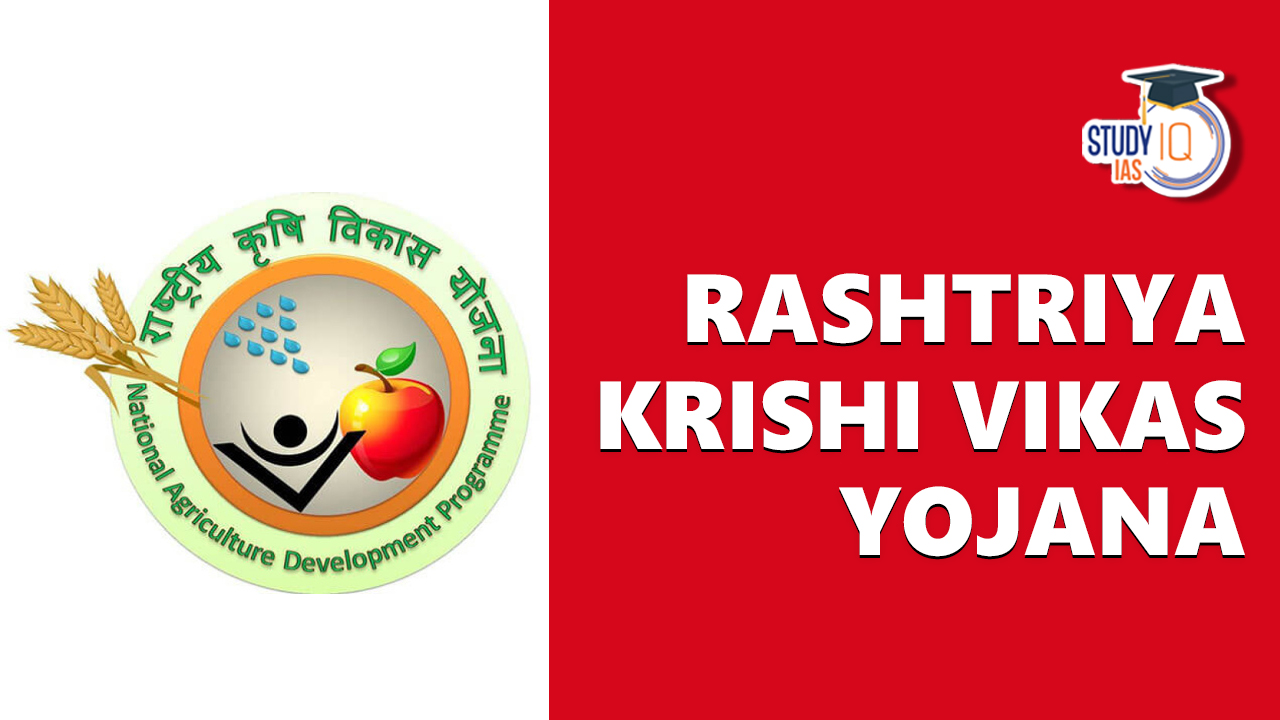Table of Contents
Rashtriya Krishi Vikas Yojana
The Rashtriya Krishi Vikas Yojana (RKVY) scheme or National Agriculture Development Program is a unique scheme of the Government of India under the Ministry of Agriculture and Farmers’ Welfare. The scheme is mainly focused on strengthening the infrastructure in agriculture and allied sectors to promote Agripreneurship and Agribusiness by enabling monetary aid and nurturing a system of business incubation.The RKVY scheme formed in the year 2007 was later revised as Remunerative Approaches for Agriculture and Allied Sectors Rejuvenation (RAFTAAR).
One of the key areas for the UPSC IAS exam is the Rashtriya Krishi Vikas Yojana (RKVY Scheme). It covers a sizeable portion of the General Studies Paper-2 syllabus’s Government Schemes topic as well as important current events for the country in the UPSC prelims.
Rashtriya Krishi Vikas Yojana Background
The Government of India introduced the RKVY programme in 2007. In accordance to the 2005 resolution of the National Development Council (NDC), the programme was started. A thorough and coordinated strategy to agricultural growth was therefore required. The programme was also designed to address the difficulties the agriculture industry was having. A few examples of this are low productivity, decreased agricultural revenues, and rising input costs.
Rashtriya Krishi Vikas Yojana Objective
It makes sure that both the district and the state create agriculture strategies, and that these strategies must be selected in light of agro-climatic factors, technical improvements, and the quantity of natural resources. The program’s main goal is to urge each state government to boost its financial support for agriculture and related services.
The objective is to limit yield gas in important products by taking intentional action. The state government is urged to create and carry out projects for agriculture and related services. It ensures that local priorities, goods, or requirements are taken into consideration in state agriculture policies. The plan makes sure farmer returns in agriculture and allied sectors are maximized.
Rashtriya Krishi Vikas Yojana Feature
It is incorporated into the National Plan. The plan promotes fusion with other initiatives like NREGS. The federal government’s grants make up the total financing strategy. As a result, the states will have extensive latitude.
The baseline expenditure is calculated as the sum of the State Government’s average expenditures for the previous three years. There will be comprehensive integration between the agricultural sector and other relevant industries. It will be taken out of the RKVY basket if the state doesn’t fulfil its promise in the ensuing years. The states must commit the monies that are left over to finish the initiatives they have already started. Due to the program’s reward structure, allocations aren’t always made.
Rashtriya Krishi Vikas Yojana (RKVY): Funding Pattern
- The North Eastern State receives 90% of its funding from the federal government and 10% from the state.
- Union Territory (UT): It is totally under the administration of the federal government.
- For all other states, there will be a 40% state contribution and a 60% federal contribution.
Rashtriya Krishi Vikas Scheme Significance
The Rashtriya Krishi Vikas Yojana project gives the states a lot of leeway and power to design and implement its programmes in order to promote investment in agriculture. This strategy helped the agrarian state’s GDP rise and promoted agribusiness. The following are a few advantages of the RKVY Scheme:
- It encourages private investment across the country in the agricultural industry.
- Demanding that more money be allocated to Indian states’ agricultural and allied businesses.
- By offering market facilities, RKVY helps to build the post-harvest infrastructure required for the advancement of agriculture and aids farmers in their endeavours.
Rashtriya Krishi Vikas Yojana (RKVY) Components
- An Introduction to Entrepreneurship: There is a two-month orientation programme with a stipend of 10,000 rupees each month. During the orientation, mentorship is given on a range of financial, technological, and other subjects.
- Funding for R-ABI Incubatees’ Seed Stage: Over Rs. 25 lakhs in finance is provided, with 15% coming from the incubator and 85% coming from loans. All R-ABI incubators will receive this. These incubators must be new Indian businesses having a minimum of two months of R-ABI experience and a legitimate presence in the area.
- Financing for Entrepreneurial Ideas at the Pre-Seed Stage: A fund of Rs. 5 lakhs, of which 10% is contributed by the incubator and 90% is funded by grants. RKVY-RAFTAAR would continue to be conducted as a Centrally Sponsored Programme in a ratio of 60:40, which implies that the government of India and the state share proportionally, with the exception of north-eastern and mountainous states where the sharing pattern is 90:10. The payment is made as a central share for UTs without conditions..
Rashtriya Krishi Vikas Yojana (RKVY) Eligibility
If a state maintains or grows its spending on agriculture and related industries as a percentage of its overall State Plan Expenditure, it qualifies for RKVY. Whereas the Base Line for these costs is the average of a State Government’s percentage of spending on Agriculture and its Allied Sectors over the three years prior, less any funding for Agriculture and its Allied Sectors that it may have previously received during that period under its State Plan.
Rashtriya Krishi Vikas Yojana Benefits
It encourages models that are part of a value chain, which raise output and productivity and provide farmers more money. It gives states the flexibility and adaptability they need to develop and put into effect policies in response to the demands of local farmers.
Using agribusiness models that emphasise agri-entrepreneurship, fostering innovation, and including young in agriculture. By emphasising alternative revenue sources like integrated farming, sericulture, mushroom farming, beekeeping, dairy farming, floriculture, etc., it reduces the risk that farmers must accept.
By building the crucial pre- and post-harvest agri-infrastructure, it supports farmer efforts by facilitating access to high-quality supplies, storage, market facilities, etc., and empowering farmers to make educated decisions.
Rashtriya Krishi Vikas Yojana: Sub –Scheme under It
- Crop diversification: Low yields and excessive water use are problems for the original Green Revolution countries. Crop diversification is the answer. A budget of Rs. 500.00 crores has been set aside for the 2013–2014 fiscal year to start a crop diversification effort that will assist technical improvement and nudge farmers towards other crops.
- National Mission for Protein Supplements: Established in 2011–12 with a budget of Rs. 300 crores, the National Mission for Protein Supplements aims to increase the production of animal-based proteins in particular blocks through livestock development, dairy farming, piggery, goat rearing, and fisheries.
- Saffron Mission: With funding from the Indian government totaling Rs. 288.06 crores over four years, the programme was launched in 2010–11. The mission’s goal was to improve J&K Saffron’s economy.
- The Vidharbha Intensive Irrigation Development Programme: It was started in 2012–2013 with the goal of protecting more farmland regions by irrigation.
- The Eastern Region’s Green Revolution: It was started in 2010–2011 with the intention of enhancing the rice-based farming systems of Assam, Eastern Uttar Pradesh, West Bengal, Bihar, Jharkhand, Orissa, and Chhattisgarh.
- Vegetable Clusters Initiative: It was stated that in order to meet the rising demand for vegetables, a major increase in production and market integration would be necessary. To achieve this, a successful supply chain must be established in order to provide high-quality vegetables at competitive prices.
Rashtriya Krishi Vikas Yojana UPSC
New initiatives and strategies will be implemented by the Rashtriya Krishi Vikas Yojana to assist farmers and encourage children to seek jobs in agriculture. By giving the states a great deal of flexibility and autonomy, the Rashtriya Krishi Vikas Yojana initiative is responsible for creating and carrying out programmes to encourage investment in agriculture. This plan was successful in boosting agribusiness and the agricultural state’s gross domestic product.


 NATO Countries List 2025, Members, Funct...
NATO Countries List 2025, Members, Funct...
 UPSC Prelims Syllabus 2025 PDF, Check Su...
UPSC Prelims Syllabus 2025 PDF, Check Su...
 UPSC Toppers 2024 Felicitation Program b...
UPSC Toppers 2024 Felicitation Program b...





















